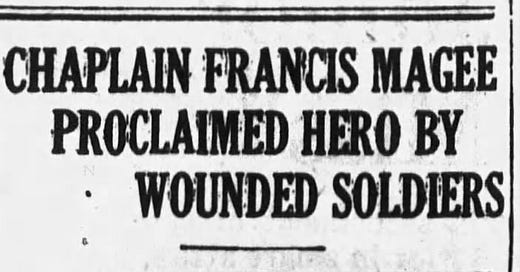“I saw one hero.” That was the observation of Pfc. Joe Smith, one of thirty-eight war-wounded soldiers convalescing in San Antonio, Texas in 1919.
Smith and the others were infantrymen recently returned from France where they saw action in the battles of St. Mihiel and the Meuse-Argonne in the closing days of the Great War.
“I saw one hero. I saw him myself carry back ten wounded men from the front and go up again. I never saw him afterwards. I don’t know who he was, except that he was a chaplain with the 357th Infantry in our Nineteenth Regiment Division. He may be dead.”
The hero was Father Francis A. Magee – and he was not dead – though his family was mistakenly informed that he had died. They lived with that sorrow for a full week until receiving a telegram correcting the unfortunate error.
On October 29, 1918, at the Battle of Argonne, a piece of shrapnel pierced one of his lungs, and he carried the piece of metal in his lung until his death in 1953.
He was awarded the Distinguished Service Medal for “among other valorous actions, on one occasion carried ten men to a place of safety while under fire.” Father Magee told a reporter of the Altoona Tribune, “I did only my plain duty, and that very poorly at times.”
Born in Nanticoke, Pennsylvania in 1881, he was a newspaper reporter before entering the seminary. Ordained in 1915, he was the first priest of the Altoona, Pennsylvania diocese to offer his service to the military, joining the Army in 1917.
Following the war, Father Magee returned to the Altoona diocese where he served as a pastor of several parishes, most notably St. Thomas in Bedford for twenty years, 1933-1953.
Only close friends knew the source of his injuries.
He died in 1953 at age 71 – the wounds he suffered contributed to his final illness and death.
Requiescat in pace, Father Francis Aloysius Magee, humble hero.





excellent.